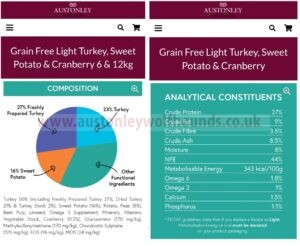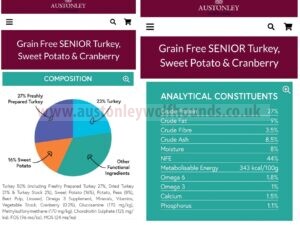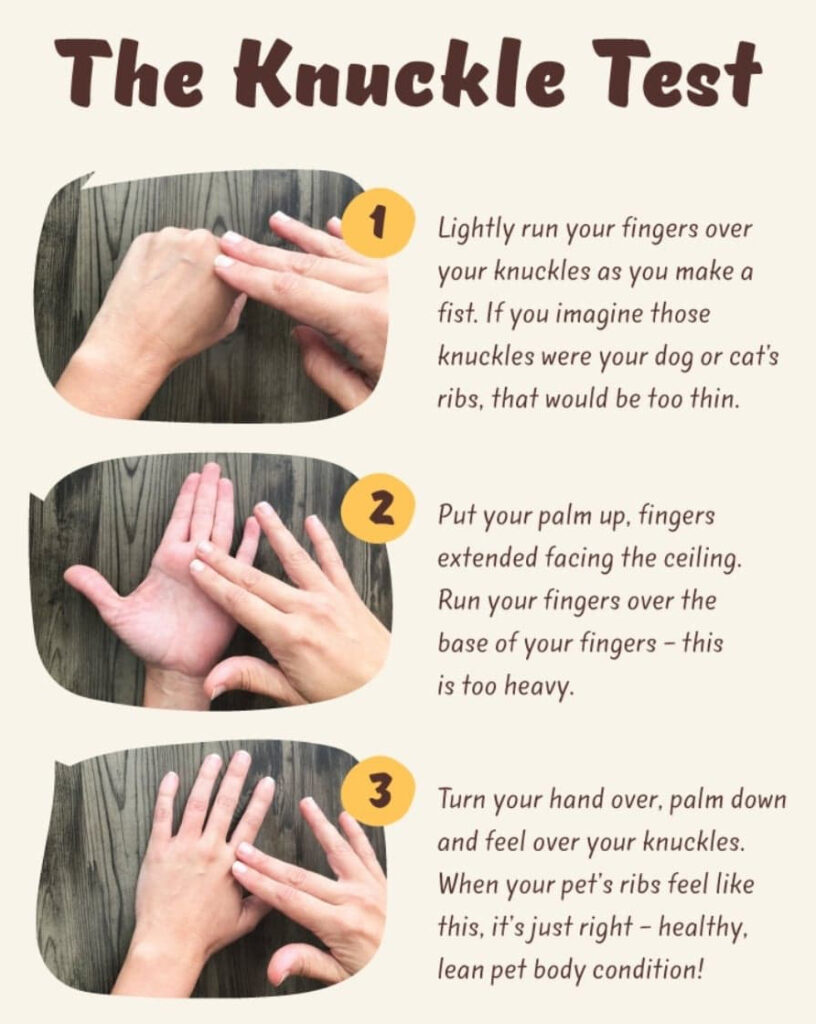(Simply click each question and it will take you to the answer)
Is grain free dog food healthier?
Does my dog have a food allergy or intolerance?
Will an elimination diet help with allergy symptoms?
Is grain free linked to Heart Disease?
What is the difference with normal dog food and working dog food?
Are all the ingredients on the label?
What if the feeding guide does not suit my dog?
How many times a day should I feed my puppy?
What is Super Premium Dog Food?
Why Will My New Puppy Not Eat?
Why is FOS & MOS in your dog food?
Is grain free dog food healthier?
Cats and Dogs have no dietary need for
carbohydrates so why are they used in pet foods?
What are grains?
Grains are a group of ingredients that contain carbohydrates and are used as fillers in pet foods, including rice, wheat, barley, sorghum, maize(corn), etc.
Does grain free mean carbohydrate free?
Not necessarily. Carbohydrates are also present in other ingredients for instance, potatoes and sweet potatoes.
Are grain free pet foods healthier?
The most important consideration when deciding what diet to feed is whether it provides complete and balanced nutrition. If there is
too much of one nutrient and not enough of others, it will impact the pet’s health. This principal is true regardless of whether the pet food contains grain or not. The nutrient profile of a product is more important than any one ingredient.
The best way to ensure a healthy diet is to feed a high quality, low carbohydrate complete pet food. After that, it comes down to consumer choice, for those that prefer a grain free petfood – there is a good selection of products on the market and vice versa.
Whilst cats and dogs have no absolute dietary need for carbohydrate, it can play an important and beneficial role in their diet. Carbohydrate in pet food provides a useful and readily available source of metabolisable energy and fibre. By using carbohydrate
instead of fat or protein to obtain energy, these other nutrients can be used to optimise healthy skin, coat, immune systems etc.
The classification of carbohydrates also includes dietary fibre. Certain fibres, for example moderately fermentable fibres (e.g. beet
pulp or rice bran), can also have a beneficial effect on the health of the digestive tract. The carbohydrate levels found in prepared pet
foods are well tolerated by the vast majority of dogs and cats.
PFMA Food Allergy & Intolerance Facts
Food allergies and intolerances are two different conditions which often have similar symptoms. They are both examples of adverse food reactions, however food allergies involve the animal’s immune system while food tolerances do not.
Food allergy or hypersensitivity
A particular component of food triggers the susceptible animal’s immune system to react, for example cells may release histamine which causes itching.
Food or dietary intolerance
Something in the food doesn’t agree with the animal’s body but does not trigger the immune system to react, for example a dog may not be able to digest cow’s milk well.
Common signs of Adverse Food Reactions
Itchy skin (also known as pruritus) and digestive upsets are the most common symptoms of an adverse food reaction, although ear problems can also occur in some dogs. It is important to remember that these are all symptoms that can also develop from non-food allergies as well.
Itchy skin is often not caused by food
It is common for people to assume that itchy skin is caused by a food allergy but true food allergies in cats and dogs are relatively rare; they are responsible for only 1% of all skin diseases in dogs and are only the third most common occurring skin allergy after flea-allergy and atopy (sensitivity to an environmental trigger like grass, dust or pollen).
Diagnosis of Adverse Food Reactions
Allergies and intolerances are poorly understood in companion animals and don’t necessarily behave the same as similar conditions in humans. Gaining an accurate diagnosis may take time and can be frustrating for pet owners, although ultimately rewarding.
Elimination Diets
With instructions from a veterinary professional, an elimination diet trial should be conducted, to remove the suspected food allergen from the diet (including any treats and extras) for an extended period of ti m e. Keeping a food d iary a nd a record of changes to clinical signs could be part of the diagnosis process. ‘Challenging’ your pet with a food allergen to see if a reaction occurs is the final step in an elimination diet trial. The aim of these trials is to identify the food allergen. This is hugely beneficial as you can then avoid feeding it to your pet, which means he/she will be able to live a comfortable and healthy life.
Types of Elimination Diets
There are a few options for elimination diets and your vet can help you decide on the most appropriate option:
• Hydrolysed diets are composed of very small protein molecules. The aim is for these small molecules not to be recognised by the immune system, reducing the risk of an allergic reaction.
• Novel protein diets include a single protein source which the pet has never eaten before and therefore hasn’t developed an allergy to. Examples of novel proteins include duck, salmon, venison and whitefish, or even more exotic ingredients such as kangaroo.
• Homemade diets are another option to control the ingredients in your pet’s food. Preparing these can be time consuming and difficult to balance, meaning they frequently provide inadequate long-term nutrition. For this reas on, home made diets are often used as a temporary measure until the right pet food product is identified.
Is Grain Free linked to heart disease?
The most recent research says NO. Click here – Review of canine dilated cardiomyopathy in the wake of diet-associated concerns
However, it is far more complex than if a food contains grain or does not contain grain. What is more important is the overall quality of your dogs diet, high quality/high meat content, low carb content is the best place to start.
Dog food labelled ‘Working Dog’ is not just for Working Dogs, Why?
To put it very simply, the label ‘Working Dog’ has absolutely nothing to do with the ingredients, composition or analytical constituents of the product in the bag and ‘Working Dog’ is not just one kind of food, a ‘Working Dog Label’ can be put on just about any kind of dry dog food ever manufactured…. if it is in a 15kg Size bag. Working Dog food is exactly the same as Pet Dog Food (you will find this stated on the government website) it is just in a 15kg bag. Just as with Pet Dogs, Working Dogs also require different protein and fat levels, depending on breed and activity level, so the myth that ‘Working Dog’ is High Protein, High Fat etc is very far from the truth. Forget the ‘Working Dog’ label and read the ingredients to gauge if the food is good quality. There are very few rules on what recipes can be labelled ‘Working Dog’, in fact, some have very low Protein and Fat Content, some are excellent quality and some are just plain crap. You will find the same varied ranges of Working Dog Food products as you will Non-Working Dog food products and within brands they are usually exactly the same product, it is only the size of bag that differs! (If I keep saying that enough, people might get it!!)
Dog Food that is Labelled ‘Working Dog’ is automatically exempt from tax, which knocks a huge 20% off the price without affecting profit. Although the Government categorise ‘Working Dog’ labelled bags as specifically for working dogs (meant so that only Working Dogs benefit from the Zero Rating in the taxation bracket), they do also state that ”it is more likely that the active working dog will simply require more food than a pet, rather than a different food”. Admitting that both working and non-working dogs eat the same food, though they claim Working Dogs are more likely to require more, this is why ‘Working Dog’ food comes specifically in the bigger 15kg size bag (again discouraging pet owners, they want you to pay the VAT!).
So why don’t all brands do a ‘Working Dog’ size bag in all of their products and save their customers 20% VAT? Very simply because a lot of dog owners are put off by the ‘Working Dog’ label and the myth that it is only suitable for actual Working Dogs. Manufacturers often make the exact same recipes in a variety of sizes and the retailers choose which ones they stock or (for example) they may offer Breeders Clubs etc for those in the know to take advantage of the ‘Working Dog’ size bags. That way, pet owners only see the smaller bags they never see the ‘Working Dog’ Label so are never put off. Pet owners are still left believing that ‘Working Dog’ is Something Else!!
Here is a good example of the effects labelling can have, using 2 of our products that are EXACTLY THE SAME RECIPE!!!!!!
AUSTONLEY’S LIGHT RECIPES VS AUSTONLEY’S SENIOR RECIPES
This applies to both the Turkey & the Salmon
The Government will not allow a ‘Light Recipe’ to be categorised as ‘Working Dog’, therefore it is only available in a 12KG Bag and the 20% VAT ‘Pet’ Tax is added, our price 12kgs = £45.53 – Non Working Dog
The Senior Recipe can be labelled ‘Working Dog’ and is available in the 15kg size bag, minus the 20% VAT (as indeed working dogs do get old and can still work). our price 15kg = £45.89 – Working Dog
THEY ARE EXACTLY THE SAME PRODUCT, THE SAME INGREDIENTS, THE SAME COMPOSITION & ANALYTICAL CONSTITUENTS – JUST LABELLED DIFFERENTLY
WHICH WOULD YOU BUY??


Some owner are also put off the 15kg ‘Working Dog’ size bags because they think it is a lot of dog food to buy all at once but dog food has a shelf life of 18 months, store it in a cool dry place, in a container with a lid and you dont have to worry about running out for a while.
The Savings you make on buying ‘Working Dog’ food can then be put towards buying better quality, healthier food for your dog.
Now, some people will read this article and their interpretation will be that I am telling everyone to feed ‘Working Dog’. No I am not, Some of it is absolutely crap, I am telling everyone to feed a High Quality Kibble that suits your budget and your dog but definitely go for the 15kg bag size option, if there is one, do not be put off by the fact it says ‘Working Dog’ on it, if it has the same ingredients, composition and analytical constituents it is exactly the same food and you will save yourself 20% VAT. Also, Compare Products, Take a look at a product in your price range that does have a 15kg ‘Working Dog’ option and you may just find it is a higher quality than you are already feeding and it is cheaper.
Pet Food Labelling Standards
All information given on a pet food label must be truthful and not misleading about the nature and quality of the product.
Statutory Statement
The law requires a statutory statement to be put on every label or package which must contain certain obligatory declarations.
Direction & Description
These must state: –
• whether the product is complete or complementary
• the species for which the product is intended;
• directions for use/feeding instructions.
Analytical Constituents
The percentage of the following must be listed:
• % of crude proteins
• % of crude oils & fats
• % of crude fibre
• % of moisture in the product when it exceeds14%
• % of crude ash (ash represents the mineral content of the food and is determined chemically by the burning of the product. % of ash is labelled as one of the following terms ‘crude ash’, ‘incinerated residue’ or ‘inorganic matter’).
Composition
The ingredients must be listed in descending order by weight. They can be indicated using category names, which are laid down by the Regulations, such as ‘meat and animal derivatives’ (derivatives mean all the crap bits), ‘cereals’, ‘derivatives of vegetable origin’. Alternatively ingredients can be listed by their own individual names. When an ingredient is used that does not fall into any of the prescribed categories, its individual name must be listed. In all other circumstances, mixing individual names and category names in the ingredients list is not permitted. If particular attention is drawn to a specific ingredient (eg With Chicken), the percentage of that ingredient component must also be listed.
Additives
If preservatives, antioxidants or colourants have been added to the product their presence may be declared on the label.
Vitamins
If Vitamins A & D are added to the product, their presence and level has to be declared. The added quantity should be declared under ‘additives’. Manufacturers may also include the total amount guaranteed at the end of shelf life (which also factors in the naturally present quantity) under ‘analytical constituents’. The Regulations also lay down the units which must be used to declare the level.
Weight Management
Follow the feeding guidelines on the pet food packet when deciding how much to feed. Remember guidelines are a starting point and you may need to adjust the amount fed dependent on the needs of the individual dog. Factors such as age, weight, levels of activity will all affect how much you need to feed. Do not be afraid to use common sense.
It’s a good idea to weigh out the food at the start of the day. This can then be apportioned throughout the day dependent on your routine and the feeding recommendations.
Healthy treats should only be given occasionally to avoid excess calories. When treats are given regularly for training reasons, they should form no more than 10% of the total energy intake (meaning 90% energy from complete food and up to 10% from treats).
It’s useful to monitor your dog’s weight on an ongoing basis. Habits change frequently and it’s good to keep an eye on their body size.

How often to feed your puppy?
There are actually 2 answers for this question.
Puppies need to be fed little and often, taking small portions from their daily food ration, which has been weighed out. This can be given at regular intervals throughout the day.
Small & Medium Size Breeds
Feed your puppy four meals a day up until the age of four months, and then reduce the feed to three meals a day until he is six months old, when you can change to two meals a day, and keep to this regime for the rest of his life.
Large & Giant Size Breeds
Feed your puppy four meals a day up until the age of six months, and then reduce the feed to three meals a day until he is 12 months old, when you can change to two meals a day, and keep to this regime for the rest of his life.
Put the dish down, give them long enough to finish the food and then take the dish back up. Puppies just like children have hungry days and not so hungry days, you must always at least offer them their meal and constantly monitor their body condition just as you would with an adult.
Make sure there is a constant supply of fresh, clean water always available.
SUPER PREMIUM PRODUCTS
Super premium product tend to include the latest nutritional developments in product formulation. As a result, Super premium diets will go beyond routine maintenance of health and see how health can be enhanced by using ingredients such as anitoxidants for immune support and glucosamine for joint care.
Why Will My New Puppy Not Eat?
Firstly, have you had your puppy checked over by a vet. It is advisable to get a vet check once your puppy is home with you. A responsible breeder will provide you with a vet check letter and ask you follow this up with your own vet check. A vet check is totally different to health testing results. A vet check is a basic examination carried out by any vet. Health testing is specific tests or xrays for a particular breed, some need to be carried out by specialists. Health tests are highly recommended as you can avoid so many heart breaking and expensive issues by knowing they exist and avoiding them. The Kennel Club will provide a list of tests that each responsible breeder should carry out on parents and offspring and Most breed clubs will have an extra list of other recommended tests.
Secondly if you are worried that your puppy is not eating because he/she is sick it is advisable to get him/her checked over by a vet.
Once we have established that puppy is not sick we need to remember that puppy has just experienced a huge change in their life.
Stress causes the release of Adrenaline and hormones, including Cortisol, this slows the appetite right down and conserves energy for the fight or flight response. Stress factors can include being taken away from mum and litter brothers & sisters, new noises, loud noises, new places, new people, new routine, confusion. All things taken into account it is not surprising that new puppy has no appetite.
Lots of people presume that new puppy does not like the food they are feeding and they change his food, they may even change it again and again. This is not a good idea and can result in puppy getting diarrhea from being switched on to new food too quickly, this plus stress and lack of nutrition can affect your puppies immunity and at this stage we would definitely not want them to come into contact with any virus or bacterial infection.
It takes any puppy time to adjust, you just have to be patient and if they need a few added healthy extras while they are settling in then so be it. Tinned Sardines, Tuna, Roast Chicken, sometimes we do have to try anything. Most importantly once they are through this natural stage of transition into their new home (which can take weeks), we should feed puppy a high quality, nutritious, balanced kibble or raw diet to provide them with all the vitamins, proteins and fats they need to develop into healthy adults.
Why is FOS & MOS in your dog food?
Salmon & Trout 50% (including 36% Freshly Prepared Salmon & Trout, 12% Dried Salmon & 2% Salmon Stock), Sweet Potato (26%), Peas, Potato (6%), Beet Pulp, Linseed, Vitamins & Minerals, Vegetable Stock, Omega 3 Supplement, Asparagus (equivalent to 7.5g per Kg of product), FOS (92 mg/kg), MOS (23 mg/kg).
FOS, short for Fructooligosaccharides is an extract from fruit and vegetables that when supplemented in dog food promotes Gastro Intestinal Health. FOS is a short chain of sugar molecules that are not digested in the stomach, they pass through to the intestines and specifically feed good bacteria, growth of these probiotics then improves immunity and digestion.
MOS short for Mannan-oligosaccharide is derived from the cell wall of the yeast Saccharomyces cerevisiae and is also added to dog food for its pro-biotic benefits plus it aids nutrient digestibility, thus improving overall well-being and energy levels.
